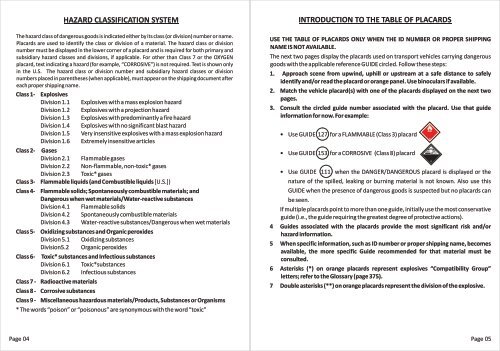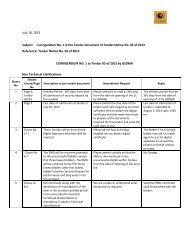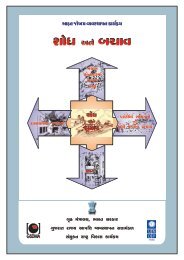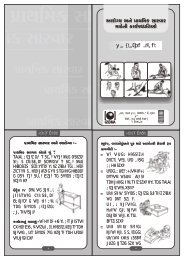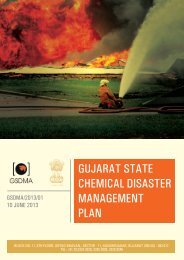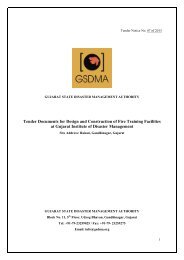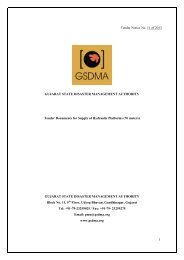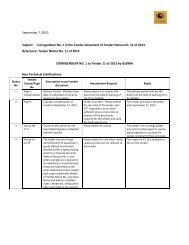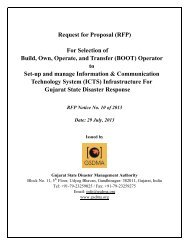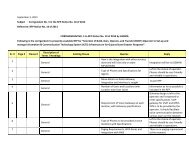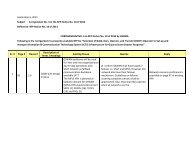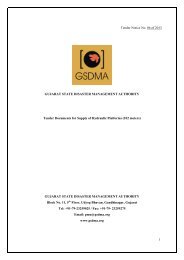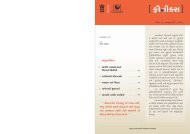Emergency Response Guidebook - Gujarat State Disaster ...
Emergency Response Guidebook - Gujarat State Disaster ...
Emergency Response Guidebook - Gujarat State Disaster ...
You also want an ePaper? Increase the reach of your titles
YUMPU automatically turns print PDFs into web optimized ePapers that Google loves.
HAZARD CLASSIFICATION SYSTEMThe hazard class of dangerous goods is indicated either by its class (or division) number or name.Placards are used to identify the class or division of a material. The hazard class or divisionnumber must be displayed in the lower corner of a placard and is required for both primary andsubsidiary hazard classes and divisions, if applicable. For other than Class 7 or the OXYGENplacard, text indicating a hazard (for example, “CORROSIVE”) is not required. Text is shown onlyin the U.S. The hazard class or division number and subsidiary hazard classes or divisionnumbers placed in parentheses (when applicable), must appear on the shipping document aftereach proper shipping name.Class 1- ExplosivesDivision 1.1Division 1.2Division 1.3Division 1.4Division 1.5Division 1.6Explosives with a mass explosion hazardExplosives with a projection hazardExplosives with predominantly a fire hazardExplosives with no significant blast hazardVery insensitive explosives with a mass explosion hazardExtremely insensitive articlesClass 2- GasesDivision 2.1 Flammable gasesDivision 2.2 Non-flammable, non-toxic* gasesDivision 2.3 Toxic* gasesClass 3- Flammable liquids (and Combustible liquids [U.S.])Class 4-Class 5-Flammable solids; Spontaneously combustible materials; andDangerous when wet materials/Water-reactive substancesDivision 4.1 Flammable solidsDivision 4.2 Spontaneously combustible materialsDivision 4.3 Water-reactive substances/Dangerous when wet materialsOxidizing substances and Organic peroxidesDivision 5.1 Oxidizing substancesDivision5.2 Organic peroxidesClass 6- Toxic* substances and Infectious substancesDivision 6.1 Toxic*substancesDivision 6.2 Infectious substancesClass 7 -Class 8 -Class 9 -Radioactive materialsCorrosive substancesMiscellaneous hazardous materials/Products, Substances or Organisms* The words “poison” or “poisonous” are synonymous with the word “toxic”INTRODUCTION TO THE TABLE OF PLACARDSUSE THE TABLE OF PLACARDS ONLY WHEN THE ID NUMBER OR PROPER SHIPPINGNAME IS NOT AVAILABLE.The next two pages display the placards used on transport vehicles carrying dangerousgoods with the applicable reference GUIDE circled. Follow these steps:1. Approach scene from upwind, uphill or upstream at a safe distance to safelyidentify and/or read the placard or orange panel. Use binoculars if available.2. Match the vehicle placard(s) with one of the placards displayed on the next twopages.3. Consult the circled guide number associated with the placard. Use that guideinformation for now. For example:• Use GUIDE 127 for a FLAMMABLE (Class 3) placard• Use GUIDE 153 for a CORROSIVE (Class 8) placard• Use GUIDE 111 when the DANGER/DANGEROUS placard is displayed or thenature of the spilled, leaking or burning material is not known. Also use thisGUIDE when the presence of dangerous goods is suspected but no placards canbe seen.If multiple placards point to more than one guide, initially use the most conservativeguide (i.e., the guide requiring the greatest degree of protective actions).4 Guides associated with the placards provide the most significant risk and/orhazard information.5 When specific information, such as ID number or proper shipping name, becomesavailable, the more specific Guide recommended for that material must beconsulted.6 Asterisks (*) on orange placards represent explosives “Compatibility Group”letters; refer to the Glossary (page 375).7 Double asterisks (**) on orange placards represent the division of the explosive.Page 04Page 05


